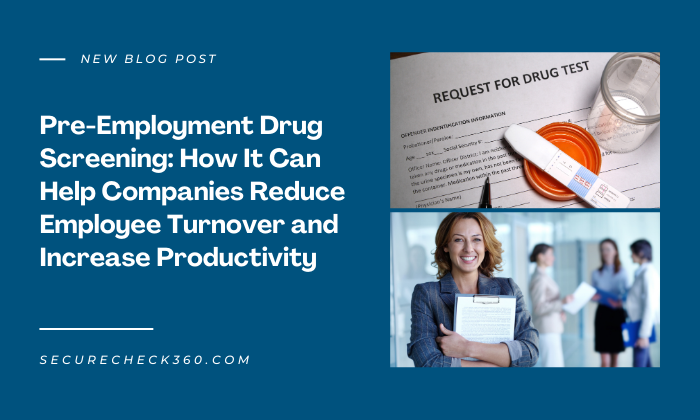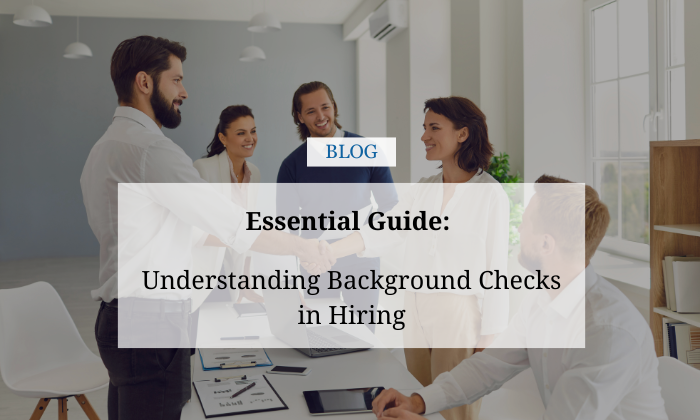Ensuring a thorough pre-employment drug screening is not just about finding the right fit for your team, it’s a strategic move to safeguard your company’s financial well-being. In an era where drug abuse has surpassed motor vehicle fatalities, with 39 states now witnessing more deaths from overdose than accidents, it’s clear that substance abuse is a growing concern.
The financial impact of employee turnover is significant, especially when drug abuse is a contributing factor. With higher turnover rates, employers face increased fiscal burdens. That’s where pre-employment drug testing becomes invaluable. By identifying applicants who may pose a risk in terms of attendance, increased insurance premiums, performance issues, and a higher likelihood of separation due to substance influence, it becomes a proactive measure to mitigate these challenges. Invest wisely in your team’s well-being and your company’s financial stability.
Securecheck360
Here at Securecheck360, we’re experts in delivering reliable, fast turnaround and affordable Employment Background Screening Services, serving businesses of all sizes across the globe. Our customized solutions are finely tuned to meet the unique requirements of small, mid-sized, and large organizations. We’re dedicated to equipping companies with the vital tools and insights they need to make well-informed hiring choices. As one of the leading background verification companies, we’re committed to supporting even small businesses as trusted background check companies for small businesses to ensure they have the confidence to build the best teams for their success.
To know more about our services, book your free demo today!
What do pre-employment drug tests look for?
Pre-employment drug testing covers a spectrum of substances, spanning both prescription and illicit drugs. Among the various testing methods available, employers typically opt for lab-based urine tests, which may involve multi-panel screenings like 4-, 5-, 8-, and 10-panel drug tests.
However, interpreting drug test results isn’t always straightforward for hiring managers and HR professionals. While results indicate a simple positive or negative, making hiring decisions requires a nuanced approach. A positive result confirms the presence of a drug in the candidate’s system but lacks context. Crucially, it doesn’t reveal details such as the frequency of drug use, potential abuse, or how the substance entered their system.
Additionally, it’s essential for employers to grasp the concept of cut-off levels in drug tests. This parameter helps determine positive or negative results. For drugs with a low minimum concentration, like opiates, there’s a risk of false positives due to trace amounts. Conversely, a high cut-off level might miss detecting minimal drug traces. It’s worth noting that certain over-the-counter and prescription medications can also contribute to false positives and confounding results. Navigating the complexities of drug testing is key to informed hiring decisions.
What is a 10-panel drug test and what does it test for?
Employers leverage the 10-panel drug test as a comprehensive screening tool to examine candidates for ten distinct illicit substances, including commonly misused prescription drugs. Typically utilizing a urine specimen, this standard test covers a range of substances such as heroin, cocaine, and prescription medications like Adderall and Xanax. It can also be expanded to detect additional opiates like Oxycodone and assess the presence of alcohol.
The 10-panel drug test specifically screens for metabolites associated with the following drug categories:
- Amphetamines (e.g., ecstasy, crystal meth, or Ritalin)
- Phencyclidine (PCP or angel dust)
- Cocaine and crack cocaine
- Opiates (e.g., heroin, codeine, or morphine)
- Marijuana
- Barbiturates
- Benzodiazepines (e.g., Xanax and Valium)
- Methadone
- Methaqualone (commonly known as Quaaludes)
- Propoxyphene
This comprehensive testing method is often applied in pre-employment screenings for sectors like law enforcement, medical professions, government roles, and other industries where substance use may impact the safety of others. In some instances, a 10-panel drug test may also be a stipulation for probation.
How long do drug test results take?
Drug testing, especially with a professional service, is swift but distinguishable in timing. A pre-employment test begins with specimen collection, usually within 1-2 days. Initial screening results take 1-5 days for labs with “Quick Tests” and 3-5 days without. Positive indications prompt further screening and scrutiny by a Medical Review Officer, with results shared in about 10 business days if needed.
How far back will a mouth swab (saliva) drug test go?
Saliva drug tests, also known as mouth swab or oral fluid tests, detect substances in a person’s saliva. The detection period for these tests is relatively short, ranging from 5 to 48 hours. How far back a mouth swab test goes depends on factors such as the drug type, quantity, frequency of use, and preparation/administration methods. For instance, while heroin may only be detectable for about an hour, marijuana can show up for up to 72 hours. Other variables include drug preparation, metabolism, and test sensitivity.
This brief detection window contrasts with blood tests (detecting drugs for a couple of days) and urine tests (showing substance presence for up to four days). Saliva tests are ideal for detecting recent or current drug use.
How much is a drug test?
The average cost of drug testing for employers can vary due to several factors, including the type and frequency of tests and the number of individuals being tested. Despite these variables, the expense is generally reasonable for employers, especially when they collaborate with a reliable Consumer Reporting Agency (CRA). Partnering with a trusted CRA can help streamline the process and ensure cost-effectiveness.
Conclusion
Drug testing is a vital aspect of ensuring workplace safety and making informed hiring decisions. Whether it’s a comprehensive 10-panel test or a quick saliva screening, understanding the nuances of these processes is essential. The duration and cost of drug testing vary, with factors like detection windows and the type of test influencing outcomes. Employers can navigate this landscape effectively, especially when partnering with reputable services. Stay informed, prioritize workplace well-being, and make strategic choices for a safer and healthier professional environment.







